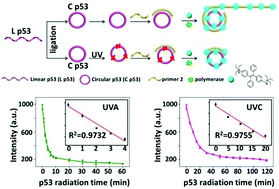Detection of UVA/UVC-induced damage of p53 fragment by rolling circle amplification with AIEgens†
Abstract
Absorption of ultraviolet (UV) light by nucleic acid could lead to mutations and skin cancers. Traditional damage detection methods based on fluorescence not only need dye/quencher groups but also display relatively high background interference, causing difficulty in synthesis and purification and thus low specificity of detection. Here, by combining rolling circle amplification (RCA) and aggregation-induced emission molecules (AIE), we made up for the defects of traditional methods to some extent and could also differentiate damaged and undamaged DNA. We also studied radiation damage of the p53 gene fragment both from UVA and UVC, although the mechanism of UVA in mutagenesis remains controversial. To amplify the signal-to-background ratio, we ligated the linear p53 (L p53) gene fragment to be a circular p53 (C p53) gene fragment, which is a key component for RCA. The combination of RCA products and positive TPE-Z (quaternized tetraphenylethene salt) molecules induced the aggregation of AIE molecules, and subsequently resulted in significant fluorescence enhancement (the signal for the undamaged DNA is 598% higher than that of the damaged). Compared with the traditional aggregation-caused quenching (ACQ) based fluorescent method, our assay was more sensitive and more specific.


 Please wait while we load your content...
Please wait while we load your content...